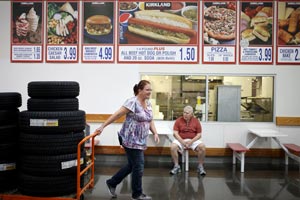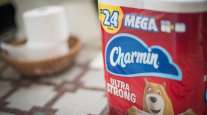Retail Sales Decrease to End Weakest Year Since 2009

Sales at U.S. retailers declined in December to wrap the weakest year since 2009, raising concern about the momentum in consumer spending heading into 2016.
The 0.1% drop matched the median forecast of 84 economists surveyed by Bloomberg News and followed a 0.4% gain in November, Commerce Department figures showed Jan. 15. For all of 2015, purchases climbed 2.1%, the smallest advance of the current economic expansion.
The slowdown, including electronics stores, clothing merchants and grocers, indicates Americans probably preferred to sock away the savings from cheaper fuel instead of splurging during the holiday season. While hiring has been robust in recent months, faster wage gains remain elusive, one reason household spending may have a tougher time accelerating in the new year.
“There isn’t anything encouraging in this report,” said Thomas Simons, a money-market economist at Jefferies Group in New York. “It’s very disappointing. The labor market is in good shape, which suggests the outlook is probably better than this.”
Estimates in the Bloomberg survey for retail sales ranged from a decline of 1% to a 0.3% advance. The November tally was revised up from a previously reported 0.2% increase.
The increase for all of 2015 followed a 3.9% gain the prior year. It was the smallest advance since demand slumped 7.4% in 2009, when the recession ended in June of that year.
A separate report from the Labor Department showed inflation remained contained at the wholesale level. The producer price index decreased 0.2% in December from the prior month and was down 1% year-over-year.
The retail sales report showed six of 13 major categories with declines in demand in December from the prior month, including a 1% slump at general merchandise stores that was the biggest since February, the report showed.
Receipts at gasoline stations dropped 1.1%. The Commerce Department’s retail sales data aren’t adjusted for prices, so lower fuel costs depress filling-station receipts.
Regular gasoline at the pump has dropped to a seven-year low, falling below $2 a gallon this week to reach $1.93 on Jan. 14, according to AAA, the biggest U.S. motoring group.
The retail report also showed sales decreased 0.9% at clothing chains and 0.2% at electronics stores.
Automobile dealers’ sales were little changed.
Industry figures earlier this month showed purchases of cars and light trucks came in at a 17.2 million annualized rate in December, the slowest since July, after an 18 million pace the prior month, according to Ward’s Automotive Group. Even so, industry sales data show 2015 was a record year for automakers.
The figures used to calculate gross domestic product, which exclude categories such as food services, auto dealers, home-improvement stores and service stations, unexpectedly dropped 0.3%. That marked the biggest decrease since February, after the prior month’s 0.5% increase in the so-called retail control group.
Warmer than usual weather last month probably curtailed purchases of winter gear including clothing. This was the warmest December on record for the contiguous United States, according to the National Oceanic and Atmospheric Administration.
Some economists may lower estimates for fourth-quarter GDP and consumer spending after the retail sales results. The median forecast in a Bloomberg survey shows household purchases rose at a 2.2% annualized rate from October through December, after a 3% pace in the prior three months.
Recent reports had signaled the November-December holiday season was mixed for retailers. Same-store sales fell in the two months for chains ranging from Macy’s Inc. to Best Buy Co. while those who snagged an increase included J.C. Penney Co. Same-store sales for the industry as a whole account for about 17% of total retail sales, which make up almost half of consumer spending.
“Growth of consumer spending ranged from slight to moderate in most districts,” according to the Federal Reserve’s Beige Book economic survey based on reports from late November to early January by regional Fed banks. “Auto sales were somewhat mixed as activity has begun to drop off from previously high levels in some districts.”
Employers added 292,000 workers in December, and payrolls for the previous two months were revised higher, the Labor Department reported last week. The jobless rate held at a more than seven-year low of 5%. Wages stagnated, with average hourly earnings unchanged from November and up 2.5% from a year earlier. They have been in the 2% range since the expansion began in 2009.




